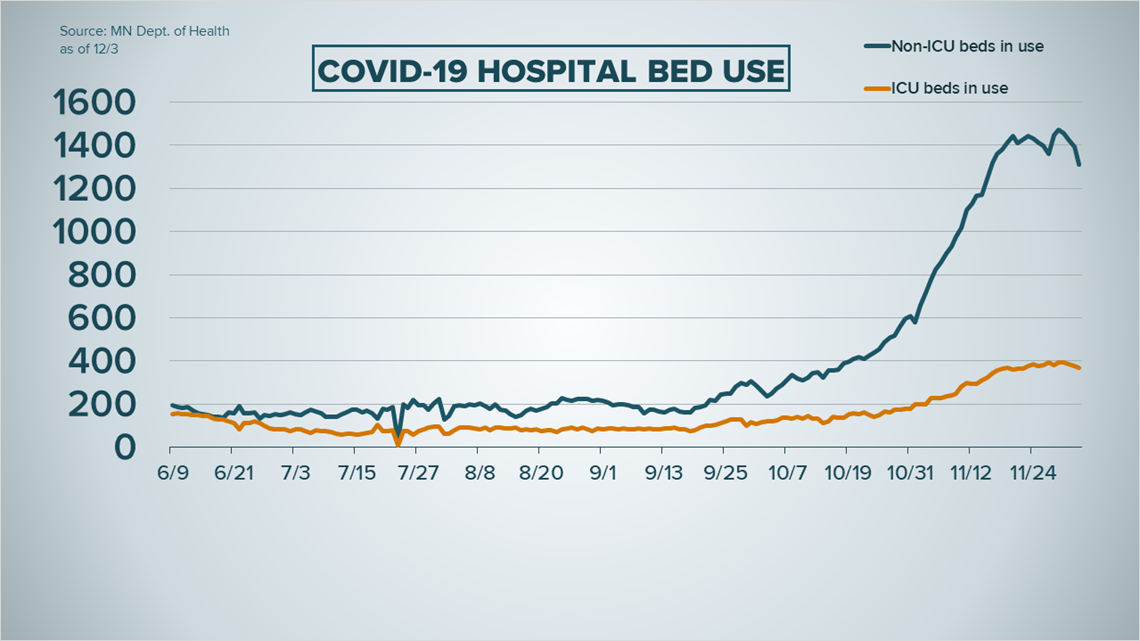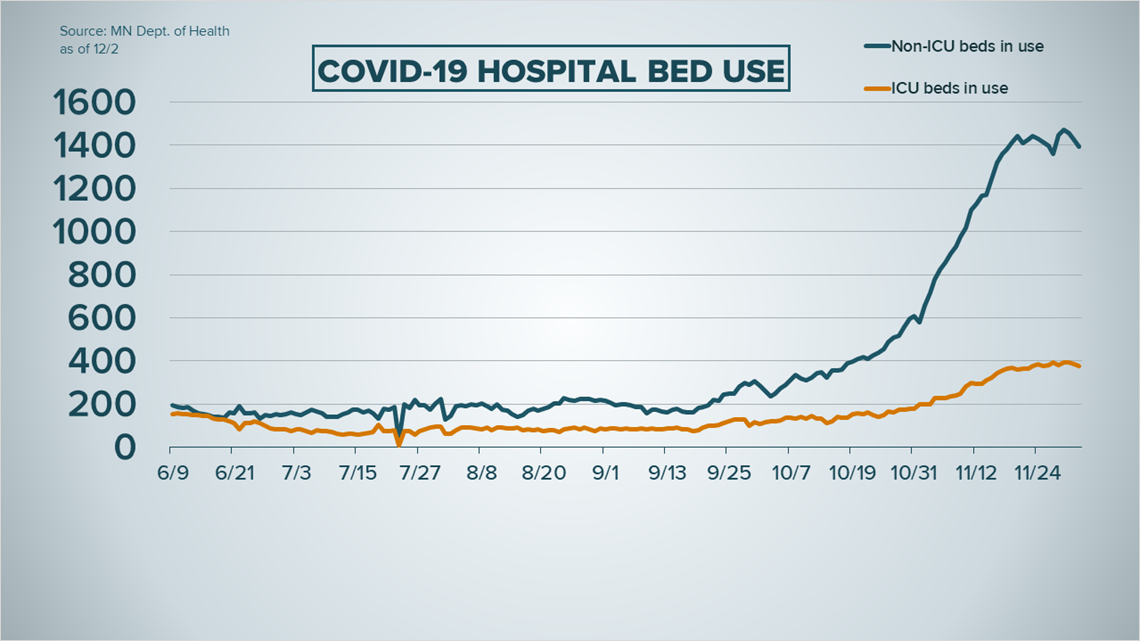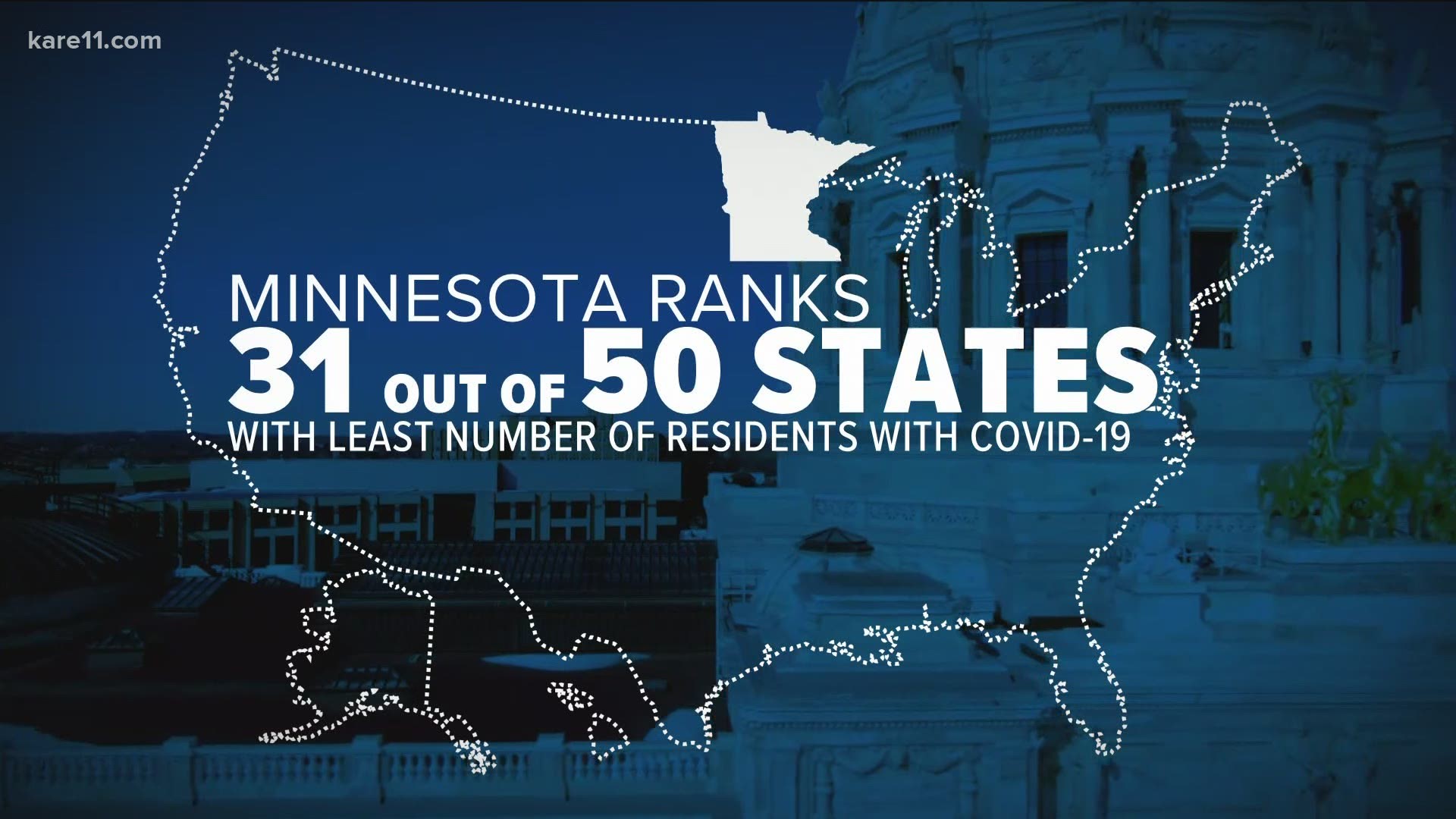Friday, Dec. 4
- CDC director predicts 'most difficult time in public health history' this winter
- COVID-19 community spread is impacting long-term care; National Guard members are helping to staff facilities
- Walz says vaccine prioritization plans will come next week, vaccines could start before Christmas
- Minnesotans have until Dec. 7 to request housing assistance
- Optimism growing for federal COVID-19 relief bill
- Biden to call for 100 days of mask wearing
2 p.m.
Gov. Tim Walz held a news conference on Friday to address the impact of COVID-19 spread on long-term care in Minnesota.
"There's not one model of a long-term care facility that is the same across the state," he said. "The one thing we do know is that it's very dangerous with COVID-19, and the behaviors that we exhibit influence them."
Walz addressed the argument he said he's heard from Minnesotans, that those long-term care facilities should just be "fenced off." The governor pointed out why that's not possible - because staff members have to go back and forth to care for the residents.
"Those people don't live there," he said. "They live in your communities. And they stop on the way home and pick up their kids from daycare."
Walz said the National Guard is being asked to help with the state's plan to combat COVID-19 in those facilities.
"Together these are some of the most vulnerable residents for getting COVID-19, having severe disease, and unfortunately dying from COVID," said Minnesota Department of Health (MDH) Commissioner Jan Malcolm.
Malcolm said the state's five-point plan has made long-term care facilities safer in general since the start of the pandemic.
- Testing has been expanded for long-term care facilities, first through the National Guard and now through many more agencies and private facilities.
- By late November, up to 60,000 tests were being performed per week in long-term care. Since April, more than 750 long-term care facilities have had coordinated testing.
- Also since April, hundreds of thousands of face masks, millions of gloves and many other supplies have been pushed out to facilities.
- The state has also helped with staffing challenges by deploying the Naitonal Guard and offering federal staffing resources. They have helped out on the ground in 12 facilities. A new volunteer matching software system also helps to fill requests for staffing shifts with volunteers, helping place people for 339 shifts in November.
- MDH has worked to better leverage partnerships with local public health providers and partners to provide support to the facilities in their communities.
Malcolm said that five-point plan has kept Minnesota in "pretty good shape." Minnesota ranks 31st out of the 50 states in cases per population in long-term care. Malcolm emphasized that the closer to 50th, the better, in this scenario - that means fewer cases. Minnesota is number 27 out of 50 in deaths in long-term care, as well.
Commissioner Malcolm said the latest data shows long-term care facilities in Minnesota are, however, being impacted by recent surging community spread.
From September to the end of October, new cases in Minnesota increased by 73%, but only by 15% in long-term care, Malcolm said. Alternatively, from the beginning of October to the end of November, new cases in both settings increased by 400%.
"That floodwall is being breached," Malcolm said.
The percentage of total COVID-19 deaths that fall among long-term care residents had been dropping, Malcolm said, but that rate is now going up again.
Cases among health care workers are increasing dramatically as well, Malcolm reported on Friday.
"So we are unfortunately seeing the effects of community spread in some of these facilities that care for some of our most vulnerable Minnesotans," she said.
Minnesota National Guard Adjunct General, Major General Shawn Menke, joined the news conference to discuss the Guard's involvement in assisting long-term care facilities with staffing.
"The state has run out of trained professionals to fill these critical roles," he said.
Guardsmen are filling the role of temporary nurse aids in those facilities, according to Menke. He said he had reservations about this plan at first.
"At the end of the day, we're all soldiers and airmen," Menke said. "We follow orders. If this is what our state needed us to do, we're going to do it."
Menke said extensive training has been done for these soldiers, and he is confident the Guard members will perform with professionalism, treating the residents of long-term care facilities with dignity and respect. The National Guard has approximately 100 members supporting long-term care currently, and 100 more who are training, Menke said.
"Not one of our soldiers or airmen envisioned themselves performing care in a long-term care facility," he said. "I wholeheartedly wish we did not have to this mission, but the fact of the matter is we are."
Menke said many of these National Guard members have to leave their families for the holidays to help with staffing needs. He asked Minnesotans to think of them - and do their part.
"I ask you to please follow the simple rules," he said. "Wear a mask when you're in public. Limit your potential exposures when you can. ... Temporarily adjust your lifestyle to limit the spread of the disease."
Menke said the work his soldiers are doing is the definition of selfless service.
"None of us like this, but all of us can make a difference if we work together in this fight," he said.
Nate Schema, vice president of operations at the Good Samaritan Society, shared his organization's struggles combating the community spread in its communities.
"This virus does not discriminate," he said. "We've got over 200 residents and team members that are positive for COVID, and we're relentlessly trying to contain it."
He said his staff is taking on new responsibilities like celebrating birthdays and anniversaries with residents who can't see their families.
Christine Dallmann, executive director at SpringBrook Village of La Crescent, said the residents and families at SpringBrook were "so excited" when they were able to start allowing visitors again.
"Unfortunately with the dramatic community spread we had to dial back a little bit and only allow the essential caregivers into the building," she said.
Even so, she said, a family member who was an essential caregiver tested positive, and the resident who was related to them tested positive as well.
"We are starting to see the light at the end of the tunnel," she said. "Now is not the time to turn our back on how we can help them."
In response to a question about vaccine distribution, Walz said he believes he will be sharing more details about the plan in "the early part of next week." Final vaccine authorization should come around Dec. 11, Walz said, and distribution should begin shortly after.
"We are in agreement with the CDC's suggestion that long-term care residents be prioritized along with health care workers," Commissioner Malcolm said. "We are required to follow the federal prioritization scheme, but there's not as much detail in the federal guidance for what we will require in Minnesota."
Malcolm pointed out that Minnesota officials will have to decide who exactly is considered a health care worker. In terms of the corrections population and other congregate living groups being included with long-term care, Malcolm said that decision will depend on whether the federal guidance specifies, or state officials are able to weigh in at all.
"We have asked for as much specificity in the federal framework as they can give us," Malcolm said.
She said things change "literally a couple times a day" in terms of timelines and number of doses available.
"We do anticipate being able to start vaccinating before Christmas," she said.
When asked about Senate Majority Leader Paul Gazelka's comments that some essential Capitol staff should get the vaccine after the elderly and health care workers, Walz said, "I haven't given that any thought."
"We'll follow the guidance as it comes out from these professionals," Walz said. "I'm just focused on the health care providers and these long-term care facilities right now."
He emphasized that an apolitical group is making the decisions on vaccine prioritization.
"This is going to take some time," he said. "Even in Minnesota, with a two-dose regimen, that's over 11 million doses. You've got to figure out how to get the PPE, when you give it, how you ship it."
Walz said he believes Minnesota will be in a good spot "by the time those trees bud out and those bats are cracking."
Malcolm said MDH is looking at updating its quarantine guidance to follow the CDC's shift from 14 days to 10 days, in the interest of getting more people to comply with a shorter term. She said new guidance should be out early next week.
Malcolm and Walz both addressed the long-term effects of COVID-19, many of which health experts don't understand yet.
"This is going to be a public health impact for decades," Malcolm said.
1:30 p.m.
The Mayo Clinic Health System is temporarily closing five clinics in order to keep up with the high volume of COVID-19 patients they're treating elsewhere.
According to a news release from Mayo, operations have been suspended at the Belle Plaine Clinic already, and Mankato-Northridge, Le Sueur, Janesville and Waterville will be suspended as of Monday, Dec. 7.
"The suspensions are necessary to reallocate staffing resources to other critical care needs in response to the COVID-19 surge," the release says. "The closures are expected to last six weeks."
Belle Plaine is still conducting COVID-19 testing. Any patients that regularly use those clinics can use other sites during the closure, or can do virtual video visits.
11 a.m.
The Minnesota Department of Health (MDH) reported 5,371 new COVID-19 cases and 61 deaths from the virus in the past 24 hours.
Friday's numbers follow a recent trend of relatively high death counts but slightly lower numbers of new cases than Minnesota has seen in the past few weeks. Hospitalizations also continue to drop.
Of the new cases reported Friday, 5,084 were from PCR tests and 287 from antigen tests. The PCR test results are considered "confirmed" cases while antigen results are considered "probable" cases.
Friday's case count comes from a testing volume of 60,544 on Thursday, including 55,794 PCR tests and 4,750 antigen tests.


As of Friday, 293,151 people who were at once diagnosed with COVID-19 no longer need to be isolated. So far in the pandemic, 17,828 people have been hospitalized in Minnesota, with 3,942 needing care in the ICU.
MDH's hospital capacity data, which is only current as of Thursday, shows that 1,679 hospital beds in total are in use by COVID patients across Minnesota, with 367 of those patients needing ICU beds. Metro ICU availability is now out of the "red zone," with 5.5% of beds available. The total hospital availability in the metro is still much lower, at 2.3%.


Gov. Tim Walz will hold a news conference at 2 p.m. Friday, along with MDH Commissioner Jan Malcolm and Minnesota National Guard Major General Shawn Menke, to talk about efforts to keep long-term care residents safe from COVID-19. That news conference will be broadcast live on KARE 11, KARE11.com, and the KARE 11 YouTube page.
Minnesotans ages 80 and up remain one of the most vulnerable groups in the state, with 2,370 deaths out of 14,097 cases - a rate of nearly 17%.
Thursday, Dec. 3
1 p.m.
Gov. Tim Walz and Lt. Gov. Peggy Flanagan are urging Minnesotans to draw upon state aid for their end-of-year housing bills.
In a media call at 1 p.m. Gov. Walz highlighted efforts to "ensure Minnesotans can afford to stay in their homes during the COVID-19 pandemic."
Minnesotans can apply for housing assistance through the United Way by calling 211 or going online at 211unitedway.org. The deadline is Monday. Dec. 7 at 11:59 p.m. As of the end of November, the state still had over $30 million available to give out to those struggling to make housing payments.
11 a.m.
COVID-19 is continuing to take a significant number of lives in Minnesota, with 92 new fatalities reported by state health officials on Thursday
Those deaths are the second highest single-day total since the pandemic began, only behind the 101 deaths reported the Friday after Thanksgiving. The total number of lives lost in the state now sits at 3,784. Thursday's near-record comes just one day after the third-highest daily death toll of 77.
The Minnesota Department of Health (MDH) says 6,166 new coronavirus cases were reported Thursday, based on results from 50,718 tests (45,885 PCR, 4,833 antigen) processed in private and state labs.
A positive PCR test is considered a confirmed case, while a positive antigen test is considered probable.
Minnesota now reports 333,626 COVID-19 cases since the start of the pandemic.
Hospitalizations due to the coronavirus in Minnesota are continuing a downward trend. COVID-19 patients are currently using 1,394 non-ICU beds across the state - 29 fewer than the day prior, and 376 ICU beds - nine fewer than the previous day. Metro bed availability has improved from 1.9% to 2.3%, and ICU bed availability in the metro has grown from 4.5% to 5.7%.
The total number of patients hospitalized since COVID hit Minnesota is 17,623, with 3,911 of those requiring treatment in the ICU.


COVID-19 case rates now put 86 of 87 Minnesota counties under full distance learning recommendations from MDH, although community spread is only one factor of many schools are instructed to use to determine their learning model.
Leading causes of exposure for those who have tested positive include community exposure with no known contact (62,312 cases) followed by a known contact (55,953 cases) and exposure through a congregate care setting (26,100 cases).
Young people 20 to 24 make up the largest group of cases with 35,289 and two deaths, followed by those 25 to 29 with 30,360 and four deaths. The greatest number of fatalities involves people 85 to 89 with 712 in 4,244 confirmed cases.
Hennepin County has the most recorded COVID activity with 70,069 cases and 1,145 deaths, followed by Ramsey County with 29,459 cases and 521 deaths, Dakota County with 23,564 cases and 198 deaths and Anoka County with 23,541 cases and 236 fatalities.
Cook County in northeastern Minnesota has the least amount of COVID activity with 80 cases and no deaths.

